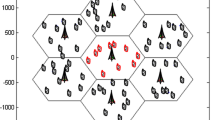Abstract
In conventional OFDMA cellular systems, mobile stations (MSs) suffer from large ICI in fully loaded cellular environments with full cell frequency reuse, especially at the cell-edge. The fundamental cause is that the signals from serving Base Station (BS) and interference BSs, are modulated by same exponential bases, at same subcarrier. In this paper, a generalized low-complexity fractional Fourier transform (FrFT) based biorthogonal frequency division multiple access (B-OFDMA) cellular system with multiple angle division reuse scheme (MADR) scheme for inter-cell interference (ICI) cancellation is proposed. FrFT angle is regarded as a kind of time-frequency combination resource (TFCR), and it can be optimally allocated to each BS of the cellular system, based on simplified minimal base correlation coefficient (MBCC) criteria, which confirms the inner-cell mutual orthogonality between modulating bases at different subcarriers, and inter-cell mutual approximate orthogonality between modulating bases at same subcarriers. Therefore, at the receiver, ICI can be dramatically suppressed by MMSE equalization and correlative detection in respective optimal FrFT domain. Extensive system simulations are conducted for various practical scenarios to demonstrate the superior performance of the proposed FrFT MADR scheme in bit error rate (BER) and system throughput, especially for cell-edge MSs, compared with conventional OFDMA cellular with different ICI cancellation schemes and scheduling schemes.
Similar content being viewed by others
References
Hwang T., Yang C., Wu G. et al (2009) OFDM and its wireless applications: A survey. IEEE Transactions on Vehicular Technology 58(4): 1673–1694
Giuliano R., Monti C., Loreti P. (2008) WiMAX fractional frequency reuse for rural environments. IEEE Wireless Communications 15(3): 60–65
3GPP TR 25.814. (2006). Physical layer aspects for evolved Universal Terrestrial Radio Access (UTRA), V7.1.0.
WiMAX Forum White Paper. (2006). Mobile WiMAX—part I: A technical overview and performance evaluation.
EP1178641. Frequency reuse scheme for OFDM systems. European Patent, SONY 2002.
3GPP R1-050833. Interference mitigation in evolved UTRA/UTRAN. LGE Electronics.
3GPP R1-082779. Proposal of inter cell interference coordination scheme. Hitachi, Ltd.
Zhang, X., He, C., & Jiang, L., et al. (2008). Inter-cell interference coordination based on softer frequency reuse in OFDMA cellular systems. 2008 International conference on neural networks and signal processing, 270–275.
Assaad, M. (2008). Optimal fractional frequency reuse (FFR) in multicellular OFDMA system. In VTC2008-Fall. IEEE 68th, pp. 1–5.
Yeh S. et al (2008) WiMAX femtocells: A perspective on network architecture, capacity, and coverage. IEEE Communications Magazine 46(10): 58–65
Kim Y. H., Kim K. S., Ahn J. Y. (2004) Erasure decoding for LDPCcoded FH-OFDMA system in downlink cellular environments. IEE 2004 Electronics Letters 40(22): 307–316
Kwon, T., Song, H., & Lee, J., et al. (2008). A power division partitioning scheme with half frequency reuse factor for OFDMA downlink systems. ICC’08, pp. 3237–3241.
3GPP2 C.S0084-001-0 v1.0. (2007). Physical layer for Ultra Mobile Broadband (UMB) air interface specification. Version 1.0.
Cheng H., Yao Y. (2010) Cognitive-relay-based intercell interference cancellation in cellular systems. IEEE Transactions on Vehicular Technology 59(4): 1901–1909
Chen E., Tao R., Meng X. (2006) The OFDM system based on the fractional fourier transform. ICICIC’06 3: 14–17
Wang H., Ma H. (2010) MIMO OFDM systems based on the optimal fractional fourier transform. Wireless Personal Communications 55(2): 265–272
Pujara, C., Mehta, P., & Desai, U. B. (2007). Chirp based multiple access technique using fractional fourier transform. ICICS 2007, pp. 1–5.
Pei V., Yeh M.-H., Tseng C.-C. (1999) Discrete fractional Fourier transform based on orthogonal projections. IEEE Transactions on Signal Processing 47(5): 1335–1348
Pei S.-C., Hsue W.-L., Ding J.-J. (1999) Discrete fractional fourier transform based on new nearly tridiagonal commuting matrices. IEEE Transactions on Signal Processing 54(10): 3815–3828
Chang P. S., Ding J.-J. (2010) Fractional fourier transform, wigner distribution, and filter design for stationary and nonstationary random processes. IEEE Transactions on Signal Processing 58(8): 4079–4092
Tao R., Li Y., Wang Y. (2010) Short-time fractional fourier transform and its applications. IEEE Transactions on Signal Processing 58(5): 2568–2580
Chang P. S., Ding J.-J. (2000) Closed-form discrete fractional and affine fourier transforms. IEEE Transactions on Signal Processing 48(5): 1338–1353
Erseghe T., Cariolaro G., Kraniauskas P. (1999) Unified fractional fourier transform and sampling theorem. IEEE Transactions on Signal Processing 47(12): 3419–3423
Kong Z., Kwok Y.-K., Wang J. (2009) A low-complexity QoS-aware proportional fair multicarrier scheduling algorithm for OFDM systems. IEEE Transactions on Vehicular Technology 58(5): 2225–2235
Zhu H. J., Hafez R. H. M. (2007) Scheduling schemes for multimedia service in wireless OFDM systems. IEEE Wireless Communications 14(5): 99–105
Author information
Authors and Affiliations
Corresponding author
Rights and permissions
About this article
Cite this article
Wang, H. Biorthogonal Frequency Division Multiple Access Cellular System with Angle Division Reuse Scheme. Wireless Pers Commun 70, 1553–1573 (2013). https://doi.org/10.1007/s11277-012-0765-5
Published:
Issue Date:
DOI: https://doi.org/10.1007/s11277-012-0765-5




